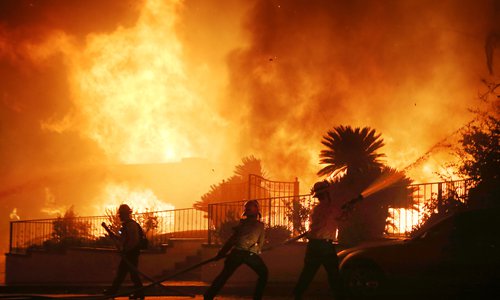HOME >> WORLD
Experts say climate change fueling California wildfires
Source:Xinhua Published: 2019/11/30 18:24:11

Firefighters work at a house fire in the early morning hours during the Saddleridge Fire on October 11, 2019 in Porter Ranch, California.Photo: VCG
Driven by record-breaking Santa Ana winds that carry dry air from the American West's Great Basin area into California, devastating fires have been sweeping through the Pacific state in recent years, driving hundreds of thousands of evacuees from their homes and decimating schools, vineyards, businesses and entire residential neighborhoods.
In 2019 alone, 6,402 fires have been reported, according to the California Department of Forestry and Fire Protection (Cal Fire) and the US Forest Service, totaling an estimated of 253,475 acres of burned land as of Nov. 28. This includes the most recent Cave Fire in scenic Santa Barbara, which has consumed 3,126 acres Friday and remains only 40 percent contained despite recent rains.
This new trend in larger, faster, less containable wildfires showed no signs of abating, experts and officials said. In fact, they warned they were here to stay, due to climate change.
"Climate change has created a new reality in the state of California. It's not a question of 'if' wildfire will strike, but 'when,'" California Governor Gavin Newsom said earlier.
"I'm not a climatologist," Ventura County Fire Department veteran Tony McHale told Xinhua in an exclusive interview early this month. "But using my own 20-year experience in the field, things in California have definitely gotten hotter and fire seasons are much, much longer."
He explained that when he was first hired two decades ago, the California fire season routinely ran from May until November. "Now they are pretty much year round," he said.
"Our two priorities are saving lives and protecting property, but some of these fires are much bigger now and more dynamic and they move really fast. They can overwhelm a community and our initial fire resources very quickly," he told Xinhua.
"Is there evidence of climate change in the fire environment? You have to say 'yes,'" Don Whittemore, a fire incident commander for 22 years in the western part of the country, said in a recent Nat Geo interview. "Every indicator is: every year it just gets worse."
The typical "Western Fire Season" in California used to run from June to September and struck most frequently in higher-elevation rural woodlands.
But a recent report co-authored by Fengpeng Sun, assistant professor of geosciences at the University of Missouri-Kansas City, identified a second fire season that spans from October to April. Its cause? Climate change, the report said.
California rains used to begin in October, but in recent years, dry periods have stretched into November, December, January, and even longer. This has lengthened the average fire season by at least 75 days, according to Cal Fire.
"We used to get more than two inches of rain in Northern California in October," said Derek Arndt, chief of the monitoring branch at the National Centers for Environmental Information, National Oceanic and Atmospheric Administration. Less than half of that reached California this year.
Unfortunately, this "new normal" second fire season is also expanding the burn zones into more densely populated areas.
"As global warming heats up California and human population continues to expand into more remote and rural areas," Yifei Sun, tenured professor of Geography and Environmental Studies at California State University, Northridge, told Xinhua Friday in an exclusive interview, "That means many more chances of someone accidentally or deliberately igniting a random spark that can lead to a massive wildfire."
Despite the Trump administration's assertion that global warming does not exist, scientific reports by experts in the field said that California had warmed by three degrees Fahrenheit over the past hundred years, a small temperature increase with an enormous impact.
"Background warming and consequent fuel drying is increasingly enhancing the potential for large fall wildfires," said Park Williams, a bioclimatologist at Columbia University's Lamont-Doherty Earth Observatory.
A report published by Williams and his colleagues said many of the most important variables that are increasing fire threats showed that California's increasingly drier landscapes, caused by climate warming trends, are "the clearest link between anthropogenic climate change and increased California wildfire activity to date."
In a report tasked with investigating California's climate change, catastrophic wildfires, and energy future, Governor Newsom revealed that 15 of the 20 most destructive wildfires in the state's history have occurred since 2000 and 10 of those since 2015.
"Wildfires don't discriminate --they are a rural, suburban and urban danger," Newsom warned.
"We need a more holistic plan to stop this," Sun said, "One that acknowledges there is global climate change and takes into account our environment, population, cultures, fuel consumption, and other variables. People and governments need the political will to make the necessary changes to stop it."
Posted in: WORLD FOCUS